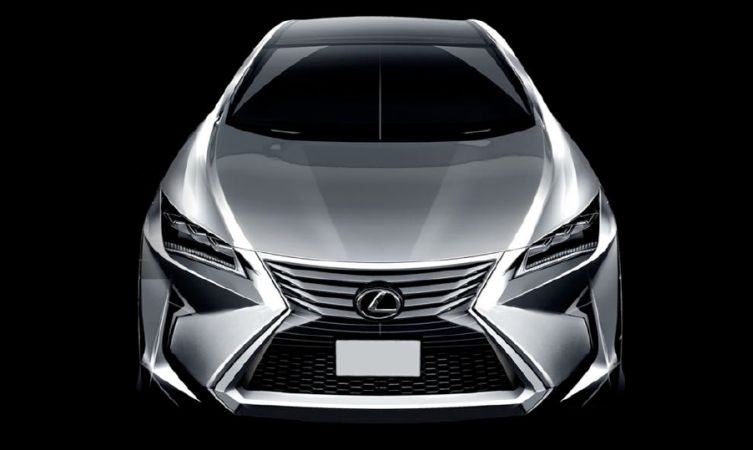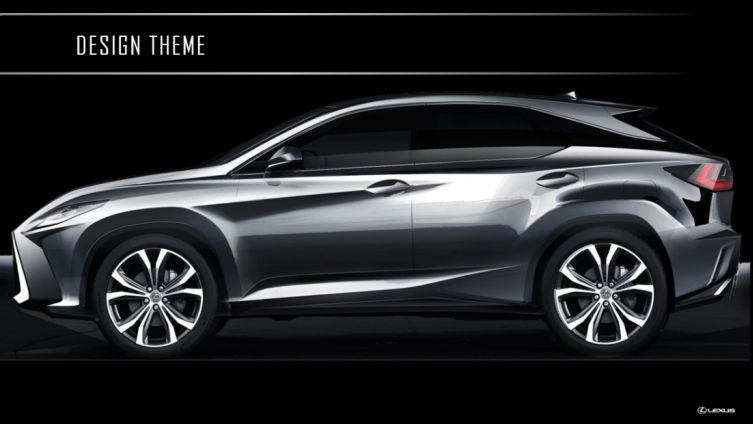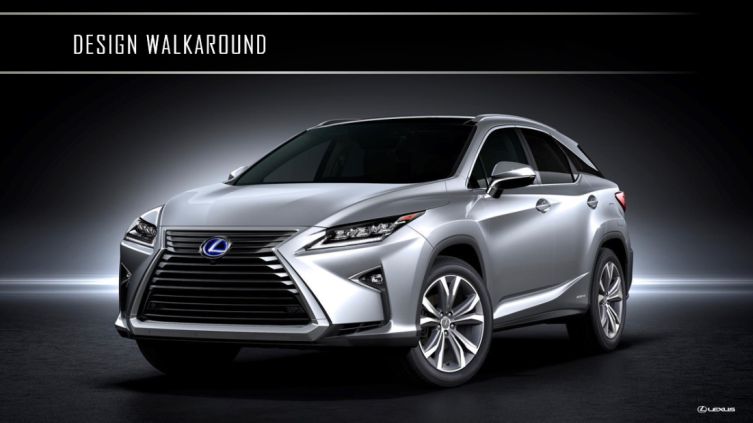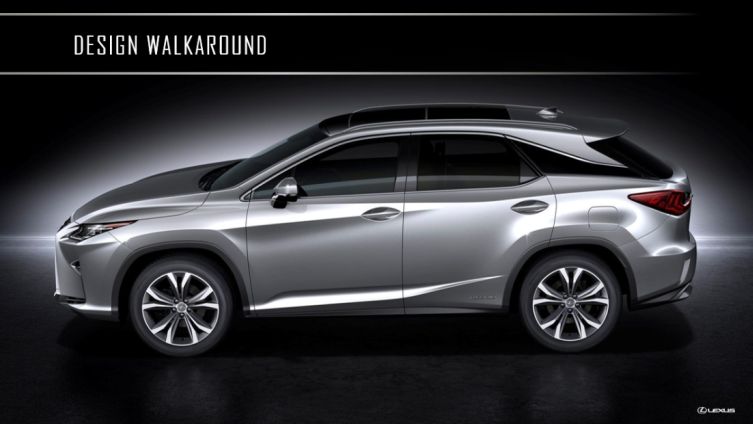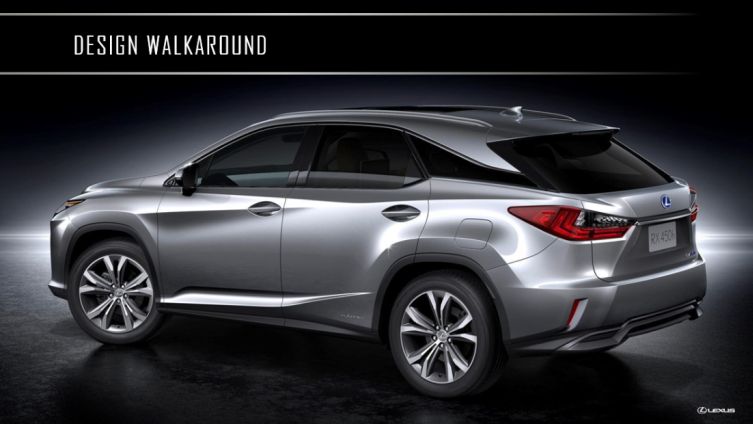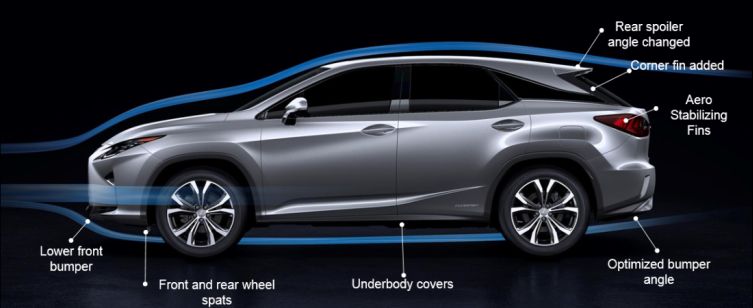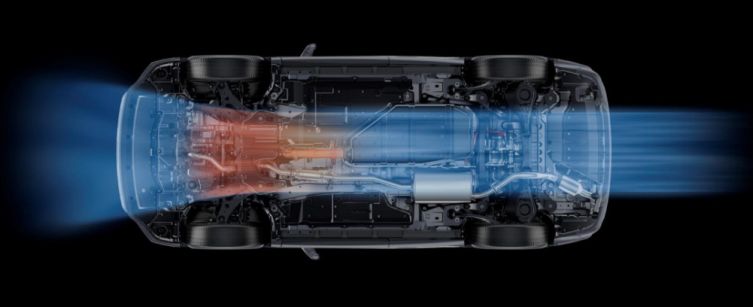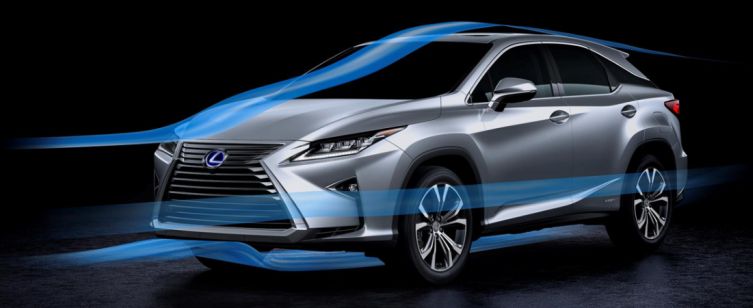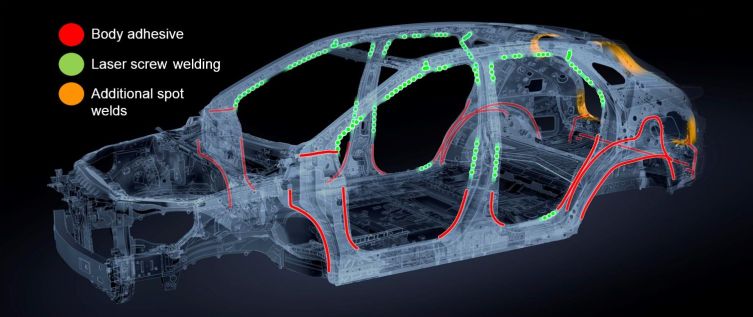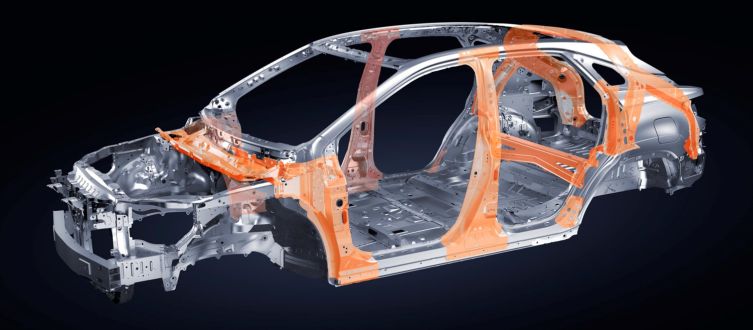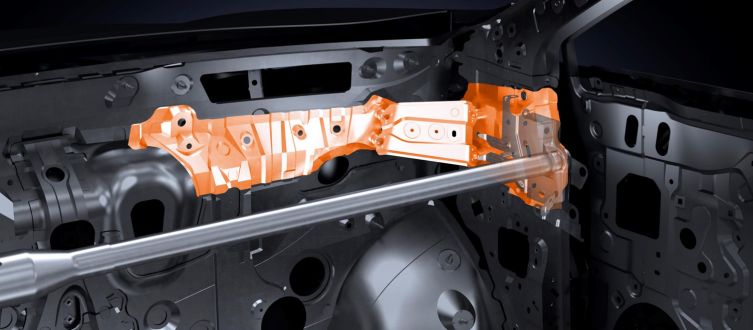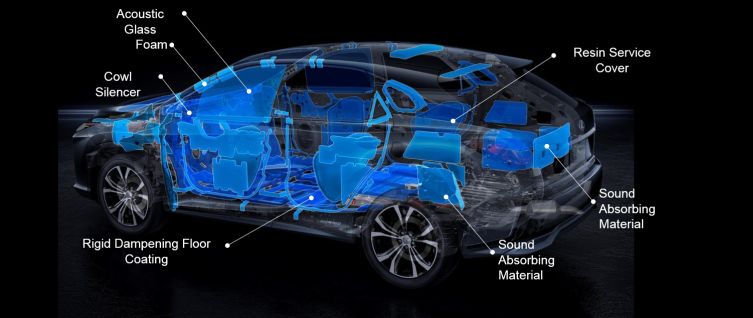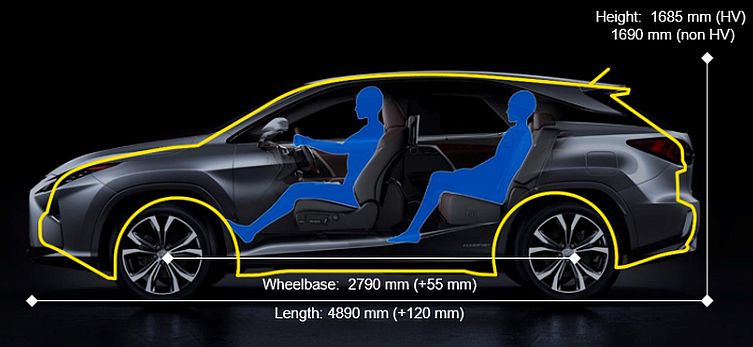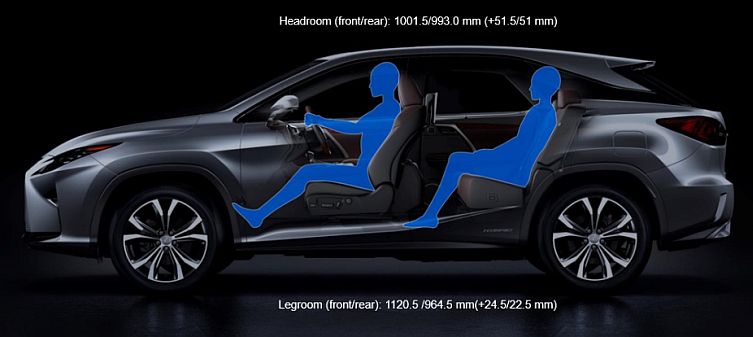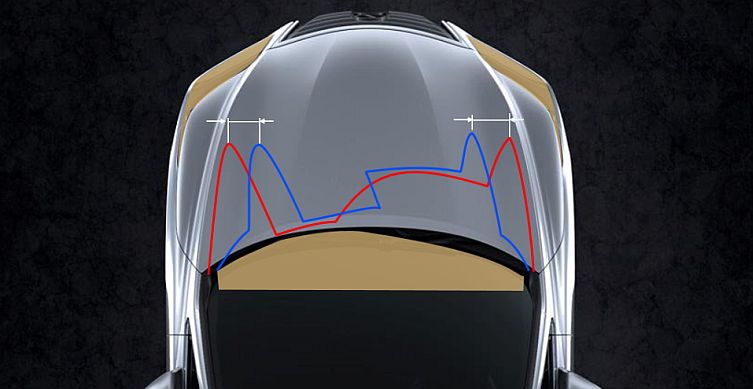2016 Lexus RX: striking design explained
The new 2016 Lexus RX displays the latest interpretation of Lexus L-finesse design – a broad philosophy that for this model was given an additional, more tightly focused direction under a design theme of Seductive Strength.
But what does Seductive Strength mean and how is this theme exemplified in the physical appearance of the new Lexus RX? Let us take you on a walkaround to reveal the answers.
In terms of an overall design theme, Lexus wanted to infuse its next-generation RX model with a look that kept its premium character intact. It had to immediately deliver the strong, athletic appearance expected of a sports utility vehicle, but juxtaposed with a hint of seductiveness that would only become apparent the more you studied the car.
A key element in this visual statement is the purposeful lower body, generated by a combination of extended wheelbase, larger wheel diameters and broadened track. This stance is further enhanced with a lower chin on the front bumper.
In the upper half of the body, moving the A-pillars rearward has accentuated the curvature of the windscreen, while the dramatic forward slant of the C-pillars gives the cabin a sleek, almost coupe-like appearance.
The front of the Lexus RX is designed to express a bold, futuristic aura, extending into an elegant silhouette as the sides come into view.
The fold-back, or pinch, point of the spindle grille is positioned relatively high so there is a powerful contrast between the thin and sharp upper section and the thick and bold lower section. Within that upper part, the grille and horizontal bars are designed to create a continuity of line and shape with the bonnet.
Examining the side of the Lexus RX, we see the bulk of the C-pillar is hidden from view behind a darkened glass panel – a distinctive design that visually separates the lower and upper halves of the body to create a floating pillar effect.
The sill area features distinct treatment, too, with complex, multi-faceted surfacing creating a gently deviating line that rises to the flared rear wheel arch – a styling cue that can also be found in Lexus IS, NX and RC models.
A similar three-dimensional effect is generated by the twin sculpted beltlines, which carve a sense of dynamic motion into the body even when the vehicle is at standstill. These important skew lines do not run parallel and do not intersect, so initially appear to be independent of each other. However, the shape of the rear doors suggests that the two lines may merge and share a common finishing point just above the rear lenses, thereby scoring a straight line between the front and rear of the car.
The rear of the Lexus RX displays aesthetic balance by subtly echoing the spindle grille design. It suggests this correspondence through the creases of the metalwork, the inner angles of the rear lenses and the location of the tailgate release bar across the visual pinch point.
When illuminated, the rear lenses are visible over a wider section of the vehicle than ever before. Although they integrate into the car’s shoulder line, the lenses do not represent the widest part of the main body. The muscular appearance is reinforced here by the rear arches, which project out from the combination lamps to create a powerful and wide stance for the rear elevation.
How the new 2016 Lexus RX cheats the wind
Vehicles in the sports utility (SUV) segment are not normally known for their wind-cheating properties, primarily due to their more upright cabin architecture and raised ride height.
However, a number of aerodynamic measures have been incorporated into the design of the 2016 Lexus RX that not only improve its drag coefficiency and fuel efficiency but also contribute to the car’s driving stability and low cabin noise.
- A lower front chin spoiler has been added to slice through the air heading around the car from that passing underneath. Airflow passing under the car is further channelled by spats around the leading edge of the front and rear wheel wells, which serve to further suppress turbulence around the tyres. These elements endow the RX with a stable feel to the front end that is akin to that of a saloon car.
- Flat covers are installed on the underside of the body to reduce aerodynamic drag and increase downforce.
- Arrow-shaped corner sections in the front fascia beneath the headlights not only form an important element of the RX’s lines but improve airflow along the sides of the vehicle. The flatter corners of the front bumper additionally serve to correct the airflow as it passes over the front wheels, minimising turbulence in the wheel arches.
- The A-pillars have been carefully shaped to increase their rake and reduce wind noise during high-speed driving.
- An anti-heterodyning system has been developed to prevent the fluttering noise often generated when the rear windows of a car are open.
- Small fins protrude from the outer edges of the rear lenses for additional aerodynamic stability at the rear of the vehicle. This is in addition to a single blade-like fin rising vertically between the C-pillar and rear screen that helps to reduce the low-pressure area of trailing wake pulling on the back of the car.
- A new rear spoiler design extends the roofline and hugs the glass area of the tailgate in order to reduce lift and add downforce.
- The departure angle at the bottom of the rear bumper has been optimised. This is especially evident on the RX 450h, where the diffuser element helps to smoothly draw airflow from beneath the vehicle to reduce aerodynamic drag and improve stability.
2016 Lexus RX – peace through strength
Lexus vehicles are renowned for delivering a driving environment that promotes a sense of calm and well-being. In fact, Lexus was the first vehicle manufacturer to be awarded a Quiet Mark distinction by the Noise Abatement Society. The new 2016 Lexus RX continues this tradition and improves upon the already exceptionally quiet cabin of the outgoing third-generation RX.
Body structure
Part of this improvement is through the implementation of cutting-edge technologies that optimise the luxury SUV’s structural integrity as well as its overall rigidity, while the rest can be attributed to design and engineering updates that focus on reducing noise and vibration.
With regards to the model’s construction, the rigid joining processes (see image above) Lexus has applied include increasing the strength of adjoining panels through the use of high-tech body adhesives and laser screw welding techniques.
High-tensile strength steel is used liberally throughout the vehicle (sections coloured orange in the image above), including key areas such as the cross members (the image below is the cross member between A-pillar and front cowl) and pillars. These form part of a new building process called annular frame construction, which reinforces the vital ring around the doors for improved strength.
In addition to contributing to better handling and a quieter cabin, these measures have the added benefit of improving occupant safety thanks to increased structural rigidity throughout the platform.
Quiet cabin
So numerous are the design and engineering refinements in the reduction of noise, vibration and harshness (often known as NVH) that we need to divide the new 2016 Lexus RX into three areas: front, middle and rear.
The front section of the vehicle:
- Wind noise around the A-pillars has been reduced by redirecting airflow around the door mirrors.
- A urethane shielding plate has been placed within the inner front wheel well to reduce the penetration of engine noise into the cabin, while a new housing material deadens noise from the road and the resonation of deflected debris.
- New, thicker insulation material has been applied under the bonnet for better sound deadening.
- The surface area to which insulation is applied on the cowling under the windscreen has been increased, while the number of holes made in this material for components has been reduced.
- Apron silencers fitted to the inner arches have been enlarged by 10-20 per cent to reduce engine noise from entering the passenger compartment.
Middle section of the vehicle:
- Acoustic glass is installed in the front and rear doors for better sound insulation and reduced noise and vibration.
- Sound-absorbing materials are applied beneath the dashboard, glovebox and centre console sections.
- Highly rigid sound-damping coatings have been applied throughout the vehicle’s floor pan for improved sound insulation with reduced weight.
- Foam, sponge and vibration-damping materials have been strategically positioned around the sills, B-pillar and roof rail sections. This is in addition to sound-absorbing and insulating materials applied throughout the doors, roof and floor sections.
- The weather strips around the front and rear doors have been redesigned and include full-edge double door seals.
Rear section of the vehicle:
- The rear body frame around the C-pillars and the body sections surrounding the rear hatchback door area has been completely redesigned and repositioned to make significant improvements in the suppression of lateral vibrations from within the rear wheel housings.
- Additional foam is placed within the C-pillar area for reduced wind noise.
2016 Lexus RX – room with a view
When researching the market prior to developing the new 2016 Lexus RX, owners of the outgoing model cited the vehicle’s dimensions as ideal for their commuting needs. Lexus designers, therefore, made it a priority to keep the body size of the new fourth-generation car relatively intact, while improving interior packaging.
You can see how the silhouette has evolved in the illustration above, the yellow line being the shape of the outgoing model. But in specific terms, the height of the new RX is identical yet ground clearance has increased by 10mm. The width has also increased by 10mm and the overall length has grown by 120mm. Meanwhile, the wheelbase has been stretched 55mm, resulting in improved legroom with the same ample luggage space.
More space all around
The position of the front seats has been lowered by 19mm, allowing excellent headroom for both driver and passenger. As a result of this, the dashboard position has been lowered and the angle of the steering column has also been lowered by two degrees to reposition the steering wheel closer to the driver. These changes contribute to the interior’s wide open and spacious feel, not to mention a more sport-oriented driving position – an attribute that will be appreciated by enthusiast drivers.
Optimised for five passengers, the new 2016 Lexus RX has a lowered floor section that helps provide rear seating accommodation and headroom comparable to that of the flagship Lexus LS saloon. In doing so, no sacrifice has been made to luggage space; the cargo area still has enough room to swallow four large suitcases or multiple golf bags.
Improved visibility
An important new design feature is an expanded field of vision through the windscreen and out over the bonnet. This improved forward visibility not only increases safety when driving but provides the driver with a more precise estimation of vehicle width. The broader field of vision is illustrated below, with the red line indicating the new 2016 Lexus RX compared to the blue line of the outgoing model.
Key to achieving this was making the A-pillars thinner and increasing their rake for a cleaner, more minimalist appearance to both the interior and exterior design. In addition, the door mirrors have been located slightly further back to reduce the blind spot between the pillar and the outside mirror.
Similarly, the C-pillars are narrower than before and the trims surrounding the rear doors are concave in cross-section in order to improve rearward visibility.
All information is correct at the time of publishing
